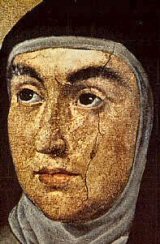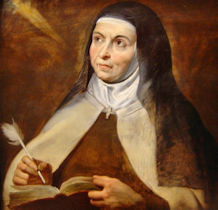Make your gift today!
Help keep Catholics around the world educated and informed.
Already donated? Log in to stop seeing these donation pop-ups.
Ordinary Time: October 15th
Memorial of St. Teresa of Jesus, Virgin and Doctor of the Church
Other Titles: Theresa of Avila; Teresa of Avila; Teresa de Avila; Teresa de Cepeda y Ahumada
» Enjoy our Liturgical Seasons series of e-books!
St. Teresa (1515-1582) was born in Avila and died in Alba, Spain. When only a child of seven, she ran away from home in the hope of being martyred by the Moors; in this way, she said she could come to see God. At the age of eighteen she joined the Carmelite Order and chose Christ as her heavenly Spouse. With the help of St. John of the Cross she reformed most of the Carmelite convents and founded new ones. She reached the highest degree of prayer and through prayer obtained such knowledge of divine things that in 1970 Pope St. Paul VI named her the first woman Doctor of the Church. Her feast is celebrated today in both the current and former (1962) calendars.
St. Teresa of Jesus
 St. Teresa of Jesus, honored by the Church as the "seraphic virgin," virgo seraphica, and reformer of the Carmelite Order, ranks first among women for wisdom and learning. She is called doctrix mystica, doctor of mystical theology; in a report to Pope Paul V the Roman Rota declared: "Teresa has been given to the Church by God as a teacher of the spiritual life. The mysteries of the inner mystical life which the holy Fathers propounded unsystematically and without orderly sequence, she has presented with unparalleled clarity." Her writings are still the classic works on mysticism, and from her all later teachers have drawn, e.g., Francis de Sales, Alphonsus Liguori. Characteristic of her mysticism is the subjective-individualistic approach; there is little integration with the liturgy and social piety, and thus she reflects the spirit of the sixteenth and following centuries.
St. Teresa of Jesus, honored by the Church as the "seraphic virgin," virgo seraphica, and reformer of the Carmelite Order, ranks first among women for wisdom and learning. She is called doctrix mystica, doctor of mystical theology; in a report to Pope Paul V the Roman Rota declared: "Teresa has been given to the Church by God as a teacher of the spiritual life. The mysteries of the inner mystical life which the holy Fathers propounded unsystematically and without orderly sequence, she has presented with unparalleled clarity." Her writings are still the classic works on mysticism, and from her all later teachers have drawn, e.g., Francis de Sales, Alphonsus Liguori. Characteristic of her mysticism is the subjective-individualistic approach; there is little integration with the liturgy and social piety, and thus she reflects the spirit of the sixteenth and following centuries.
Teresa was born at Avila, Spain, in the year 1515. At the age of seven she set out for Africa to die for Christ, but was brought back by her uncle. When she lost her mother at twelve, she implored Mary for her maternal protection. In 1533 she entered the Carmelite Order; for eighteen years she suffered physical pain and spiritual dryness. Under divine inspiration and with the approval of Pope Pius IV, she began the work of reforming the Carmelite Order. In spite of heavy opposition and constant difficulties, she founded thirty-two reformed convents.
Truly wonderful were the exterior and interior manifestations of her mystical union with God, especially during the last decade of her life. These graces reached a climax when her heart was transfixed (transverberatio cordis), an event that is commemorated in the Carmelite Order by a special feast on August 27. She practiced great devotion to the foster-father of Jesus, whose cult was greatly furthered throughout the Church through her efforts. When dying she often repeated the words: "Lord, I am a daughter of the Church!" Her holy body rests upon the high altar of the Carmelite church in Alba, Spain; her heart with its mysterious wound is reserved in a precious reliquary on the Epistle side of the altar.
St. Teresa composed the following well-known lines:
Let nothing affright thee,—Excerpted from The Church's Year of Grace, Pius Parsch.
Nothing dismay thee.
All is passing,
God ever remains.
Patience obtains all.
Whoever possesses God
Cannot lack anything
God alone suffices.
Patronage: against bodily ills; against headaches; against heart disease; lacemakers; loss of parents; against the death of parents; heart patients; lace makers; lace workers; people in need of grace; people in religious orders; sick people; opposition of Church authorities; people ridiculed for their piety; Spain; those named Teresa, Theresa, Teresita, Terry, Tessa, Teresina, and Tracy; Spain; Avila, Spain; Pozega, Croatia; diocese of Amos, Canada; diocese of Avellaneda–Lanús, Argentina; Italy: Berzano di Tortona, Borgo Tressanti, Gesturi
Symbols and Representation: nun in habit of a Discalced Carmelite; Carmelite nun with her heart pierced by an arrow held by an angel; Carmelite nun holding a pierced heart, book and crucifix; Carmelite nun with book and quill; Carmelite nun receiving a message from a dove; roses and lilies; inflamed heart; IHS on a heart; flaming arrows; dove; book and pen; crown of thorns; heart transfixed with flaming arrows; scapulary; crucifix and lily
Highlights and Things to Do:
- Listen to the Catholic Culture Audiobook: Richard Crashaw—A Hymn to the Name and Honour of the Admirable Saint Teresa read by James Majewski.
- Read St. Teresa's bookmark. Perhaps as an art project write and decorate it, to keep it nearby as a reminder, or place in your own prayer book.
- Learn more about St. Teresa:
- Bake a special Spanish recipe, such as Paella, or Gazpacho or learn more about the variety of tapas. Also try your hand at some of the recipes bearing Teresa's own name, such as St. Teresa's Egg Yolks or Yemas or St. Teresa's Bread.
- Find out more about the Discalced Carmelites, and the hard sacrifices they follow in their Rule.
- Migraine and headache sufferers have a patron to invoke!
- See St. Teresa's status on St. Peter's Basilica Colonnade and her Founder's Statue within St. Peter's Basilica.
- St. Teresa did not die on October 15, but she had the unique privilege of dying around midnight of October 4, 1582. After so many centuries of following the Julian Calendar, it was realized that the days didn't add up quite right, and needed some adjusting for the anomalies. Pope Gregory VII Issued the papal bull Inter Gravissimas, which ordered 10 days to be removed from the calendar, October 5-14, 1582. Hence, St. Teresa's feast was marked on the "next" day from October 4, which that year was October 15. Find out more, and see why we have Gregory VII to thank for Leap Year.
- Read the Autobiography of St. Teresa. See how human her writing is. Her other books Interior Castle and Way of Perfection are more difficult and lofty to read, but are spiritual classics. The books may also be downloaded online: The Life of St. Teresa of Jesus, Interior Castle and Way of Perfection.






